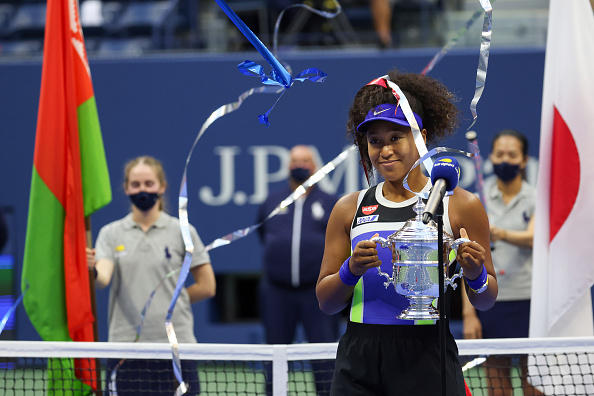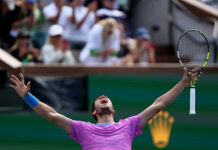Bill Simons
We all know it. Our little world is not so happy. COVID-19, racial unrest, wildfires, political fury – enough already. And there were aspects of the US Open that weren’t all that happy, either. Yes, it was a sporting miracle that it even happened – Hallelujah! Yes, here were triumphant mothers and a surging collegian, but there was no Roger and no Rafa. A Frenchman got COVID and a Nole got booted. In a brave new fan-free world, silence reigned and Serena again fell short.
But a 22-year-old, born in Japan, reared in New York and Florida and now living with her boyfriend in LA, touched our hearts and lifted our spirits. The second richest athlete in the world again inspired.
As a 16-year-old, she drew our attention. Her forehand had impact, but not as much as her whimsical humor. She joked that everyone from the Japanese city of Osaka was named Osaka.
It took years before we really got to know her. Naomi’s grace shined at the dystopian 2018 US Open final. She played clutch ball to win the 2019 Australian Open over Petra Kvitova. Still, it was easy to peg her as a delightful innocent dancing freely in tennis’ highest meadows. She let us into her bemused universe. We were charmed by her breezy transparency and endearing spirit.
But behind the scenes there were ominous clouds and a gnawing coming-of-age angst. Coaches were fired, and she wrestled with depression. Her ranking dipped. Then came COVID – and a realization: “The biggest thing was to grow as a person and lessen the regrets I have.” The death of George Floyd was an epiphany. She flew to his memorial site in Minneapolis and “decided it was a time to speak up.”
She wrote in Esquire, “What I will say here, I would never imagine saying two years ago…Being not racist is not enough.” The innocent we relished was now becoming an unlikely activist. On her own, she pulled out of the Western and Southern semis, saying that there were more significant things to do than playing a tennis match. At the US Open, her masks honored seven fallen African Americans: Breonna Taylor, Elijah McClain, Ahmaud Arbery, Trayvon Martin, George Floyd, Philando Castile and 12-year-old Tamir Rice. Always candid, she viewed herself as just a vessel. Her authenticity was powerful.
But in the opening set of the final against Victoria Azarenka, her power was muted against a foe who also inspires. Vika once seemed to have it all. She won two Slams and was No. 1 for 51 weeks. She had a rock-and-roll boyfriend, Olympic medals on her shelf and millions in the bank.
She broke up with her boyfriend, and her world broke apart. Then came an unexpected pregnancy, the joys of motherhood, the anger of a grim custody battle and a dreary string of losses. She had more coaches – five of them – than wins. Her ranking flatlined in the 40s and 50s. Her ego was battered – tears fell. Although her shrieks still rang loud, her glory vanished.
Oh, well. Vika took refuge in what she calls a “neutrality” mindset. At last she started to enjoy tennis. She recalled, “You can start to think you’re invincible and you’re better than everybody, and it’s not true. So the ego starts to grow. It’s very hurtful when it gets damaged, so..I tried to remove that, and learn….that being a tennis player doesn’t make you better or worse than anybody else.”
Before the COVID shutdown, Vika hadn’t touched a racket for five months. She often considered retiring, but then at last she prevailed in her custody case.
As tens of thousands battled a dictator on the streets of her Belarus homeland, in New York Azarenka battled her way to the Western and Southern title, then just kept on winning as she streaked to the semis of the US Open. Surely there Vika’s bubble would burst. She had a 4-18 record against her nemesis, Serena, and got hammered 1-6 in the first set. In a tournament marked by extraordinary comebacks, Vika battled bask and prevailed.
In the final today, she turned the tables in the first set and demolished a surprisingly flat and shell-shocked Osaka by that same lopsided 6-1 score. Vika’s serve was on fire as she made 25 of her first 28 first serves. She calmly ran Osaka wide, and her slice was wicked. Guns blazing, she controlled the middle of the court and went up 6-1, 2-0, 40-30. What a rout. “It’s the old ‘bad day syndrome’ [for Osaka],” said Chris Evert. “Sometimes it’s just not there.”
Mother Vika would surely nurse her lead, score the mother of all WTA comebacks and win her third Slam after a painful seven-year drought. In 25 years, no woman had come back to win the Open after losing the first set. But the mantra of the tournament has been, “Never underestimate Osaka.” Yes, she seemed hapless at the beginning. She dropped her racket, looked to the sky and punched her thigh.
But once Naomi has reached a Slam quarterfinal she’s never lost. Plus, Vika blinked. Two forehand errors opened the door and Naomi broke back, and promptly gained the uncanny confidence that’s one of the biggest weapons in tennis. Finding her range, she came out of her stupor, stepped in and was more aggressive. Her serve came alive. Her forehand seemed like a cannon. She redirected the ball with ease and won many long, dramatic power battles. At last Vika’s serve failed to rule, as Naomi took the second set 6-3 and raced to a 3-1 lead in the third.
But Vika battled back in a tense game, only to face more power from Osaka, who saved three break points. Naomi had a chance to close the door but couldn’t convert four break points. Emboldened, Vika broke back to bring the match on serve. But Osaka didn’t waver. She hit even bigger, broke Vika and served for the match.
Finally after 1:53, on Osaka’s second championship point, an Azarenka backhand dropped tamely into the net. Osaka, with her 1-6, 6-3, 6-3 win, fell to the ground. Her curly black hair splayed like a halo on the big blue court in the nearly empty arena. Her broad shoulders, still glistening with sweat, at last were at rest. She stared, almost blankly, upward. We wondered, was she thinking about how she was able to turn around this epic battle, or how she survived the chaos of Arthur Ashe Stadium in 2018, the pain of discrimination she’d felt as a child or her mom leaving for work at 4:00 AM? Later Osaka, who’d just claimed her third Slam in two years, explained: “I was thinking about all the times I’ve watched the great players collapse onto the ground and look up into the sky. I’ve always wanted to see what they saw. It was really an incredible moment.”
On court, a serene, Mona Lisa smile came to Naomi’s face. It revealed the deep satisfaction champions feel and the surprisingly deep inner life of a still young athlete.
For her part, Azarenka admitted her disappointment, but was at ease. “When things don’t go your way, it’s more fun to figure it out rather than being like, ‘Oh, shit, I’m in trouble, what am I going to do?’
“That is more fun because I’m looking for solutions…My mentality [in recent times] has been a lot more fun. When you’re young, you have some not so great people around you who put you into this tunnel vision: ‘Don’t look right, don’t look left.’ You’re becoming this focused machine as a tennis player…You’re kind of missing the point of living.”
In her gentle but powerful way, Osaka has been making a point or two about living. She noted, ‘I’ve definitely tried to mature. I feel the lessons I learned definitely developed me as a person.” Then she was asked about George Floyd. She said, “At this point there are certain things I do that I hope can make him proud, like keeping his legacy alive. It’s amazing how one person can inspire so many.”
Exactly. And today Osaka was a vessel who inspired.




















